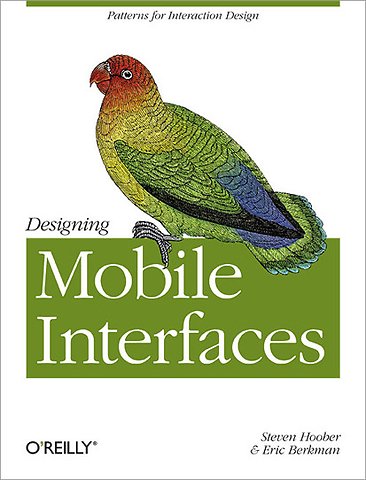


Steven Hoober has been documenting design process for all of his 15 years in interactive design, and entered mobile full time in 2007 when he joined Little Springs Design.
Meer over de auteursDesigning Mobile Interfaces
Patterns for Interaction Design
Samenvatting
With hundreds of thousands of mobile applications available today, your app has to capture users immediately. This book provides practical techniques to help you catch-and keep-their attention. You'll learn core principles for designing effective user interfaces, along with a set of common patterns for interaction design on all types of mobile devices.
Mobile design specialists Steven Hoober and Eric Berkman have collected and researched 76 best practices for everything from composing pages and displaying information to the use of screens, lights, and sensors. Each pattern includes a discussion of the design problem and solution, along with variations, interaction and presentation details, and antipatterns.
- Compose pages so that information is easy to locate and manipulate
- Provide labels and visual cues appropriate for your app's users
- Use information control widgets to help users quickly access details
- Take advantage of gestures and other sensors
- Apply specialized methods to prevent errors and the loss of user-entered data
- Enable users to easily make selections, enter text, and manipulate controls
- Use screens, lights, haptics, and sounds to communicate your message and increase user satisfaction
Specificaties
Over Eric Berkman
Inhoudsopgave
Part 1: Page
1. Composition
-A Little Bit of History
-A Revolution Has Begun
-Composition Principles
-The Concept of a Wrapper
-Context Is Key
-Patterns for Composition
-Summary
Part 2: Components
2. Display of Information
-Look Around
-Types of Visual Information
-Classifying Information
-Organizing with Information Architecture
-Information Design and Ordering Data
-Patterns for Displaying Information
3. Control and Confirmation
-Quiet, Please
-That Was Easy
-Understanding Our Users
-Control and Confirmation
-Patterns for Control and Confirmation
4. Revealing More Information
-It's Not Magic!
-Context Is Key
-Designing for Information
-Patterns for Revealing More Information
-Summary
Part 3: Widgets
5. Lateral Access
-What a Mess!
-Lateral Access and the Mobile Space
-Follow the Principles of Wayfinding and Norman's Interaction Model
-Wayfinding
-Norman's Interaction Model
-Patterns for Lateral Access
6. Drilldown
-Get Ready to Push!
-Maybe We Won't Have to Push
-Drilldown and the Mobile Space
-Patterns for Drilldown
-When to Use Links, Buttons, and Icons
7. Labels and Indicators
-Down Under and Backward
-Understanding Our Users
-Labels and Indicators in the Mobile Space
-Patterns for Labels and Indicators
8. Information Controls
-The Weilers, Version 1
-The Weilers, Version 2
-The Difference
-Information Controls in the Mobile Space
-Patterns for Information Control
-Summary
Part 4: Input and Output
9. Text and Character Input
-Slow Down, You're Too Fast!
-The Status Quo
-Use What's Best for You
-Text and Character Input on Mobile Devices
-Patterns for Text and Character Input Controls
10. General Interactive Controls
-Darkness
-That Sounds Like a Great Idea
-Gestural Interactive Controls
-Patterns for General Interactive Controls
11. Input and Selection
-The Wheels on the Bus Go Round and Round
-Mobile Trends Today
-Slow Down, Teen Texters!
-Input and Selection in the Mobile Space
-Patterns for Input and Selection
12. Audio and Vibration
-The Big Tooter
-The Big Tooter Today
-The Importance of Audition
-Auditory Classifications
-Audio Guidelines in the Mobile Space
-Audio Accessibility in the Mobile Space
-The Importance of Vibration
-Patterns for Audio and Vibration
13. Screens, Lights, and Sensors
-The Relationship
-The Breakup
-I'm Not “Everyman”
-Context of Use
-Displays
-Mobile Display Technology
-Sensors
-Patterns for Screens, Lights, and Sensors
-Summary
Appendixes
Appendix A: Mobile Radiotelephony
Appendix B: Mobile Typography
Appendix C: Human Factors
Appendix D: About the Authors
References
Index
Anderen die dit boek kochten, kochten ook
Net verschenen
Rubrieken
- aanbestedingsrecht
- aansprakelijkheids- en verzekeringsrecht
- accountancy
- algemeen juridisch
- arbeidsrecht
- bank- en effectenrecht
- bestuursrecht
- bouwrecht
- burgerlijk recht en procesrecht
- europees-internationaal recht
- fiscaal recht
- gezondheidsrecht
- insolventierecht
- intellectuele eigendom en ict-recht
- management
- mens en maatschappij
- milieu- en omgevingsrecht
- notarieel recht
- ondernemingsrecht
- pensioenrecht
- personen- en familierecht
- sociale zekerheidsrecht
- staatsrecht
- strafrecht en criminologie
- vastgoed- en huurrecht
- vreemdelingenrecht





